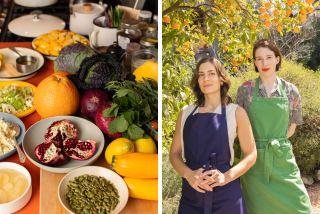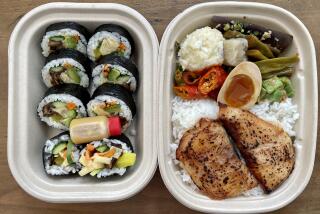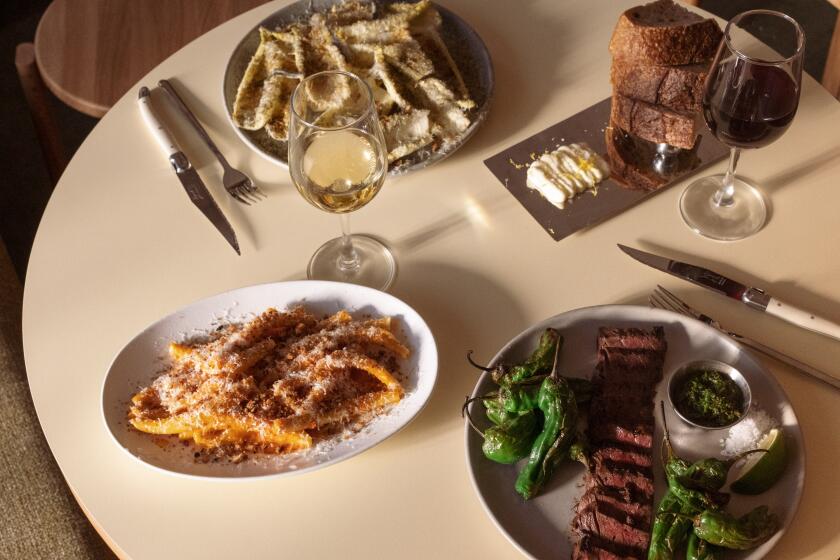Five or Fewer: Keto recipes made for everyone
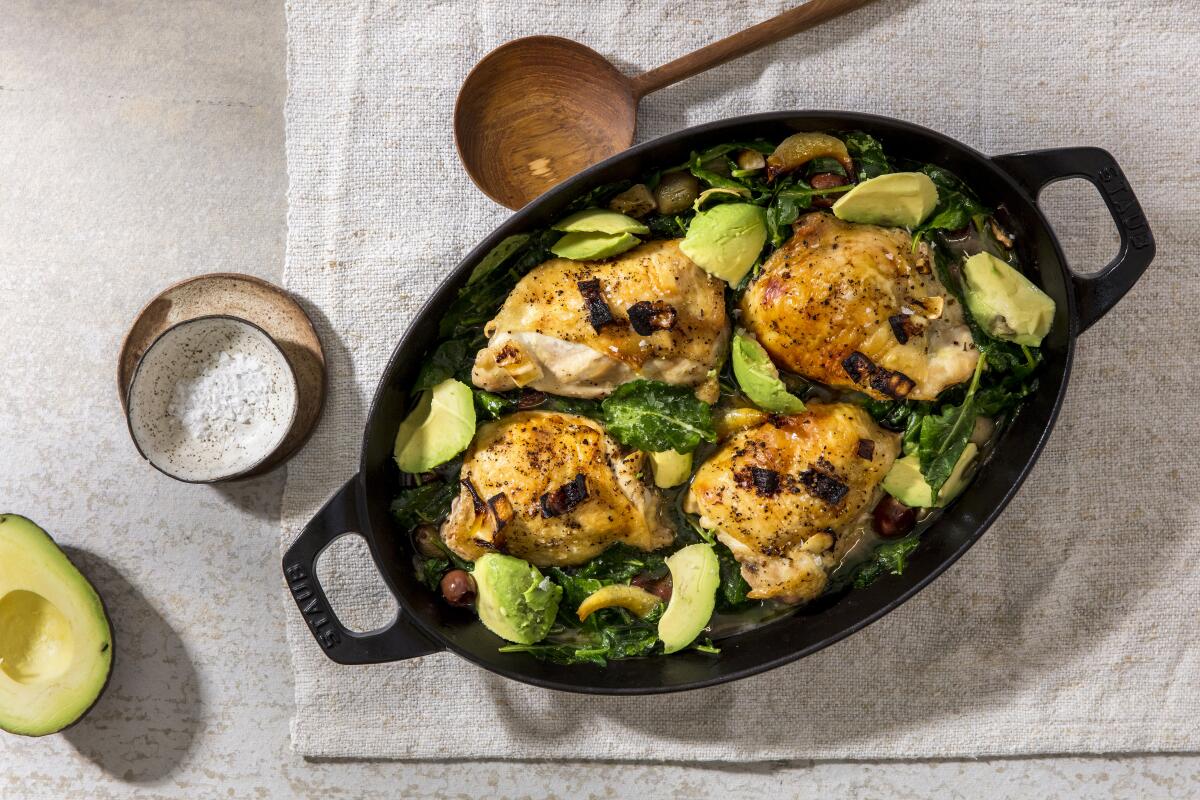
As I’ve cycled through fitness regimens and diets to get in shape for swimsuit season or for my overall health, I’ve always found them easy to follow in a vacuum, cooking at home for myself. But as soon as I want to invite friends over, the diet and its restrictions come crashing down because diet food is by design not celebratory food.
This year’s diet frenzy is about keto, which is a reimagined, stricter version of Atkins and low-carb diets. It has specific guidelines on eating mostly protein and fat and very little to no carbs, which includes restricting or eschewing not just fruit and grains but also beans and root vegetables. The goal is to switch your body’s mechanics so it burns fat instead of carbohydrates, a state of operations called ketosis.
The recipes in keto cookbooks often contain mutations of classics with odd ingredient substitutions like meatballs and, er, zucchini noodles. In my view, substitutions like that shine a spotlight on what you can’t eat instead of embracing what you can. So I’ve developed a slate of dishes that will work for keto dieters (I’ve broken down the macros for each, if you want to track them) but that I’d also be perfectly happy putting on the table in front of friends who aren’t on a health trip.
You can serve these dishes on their own or with sauteed vegetables and/or simple green salad. Each has only five ingredients, not counting salt, pepper and oil, and each comes with three extra flavor profiles, so you can switch up each dish for variety if you get bored. Each dish works just as effectively as a weeknight meal as it does an entertaining centerpiece.
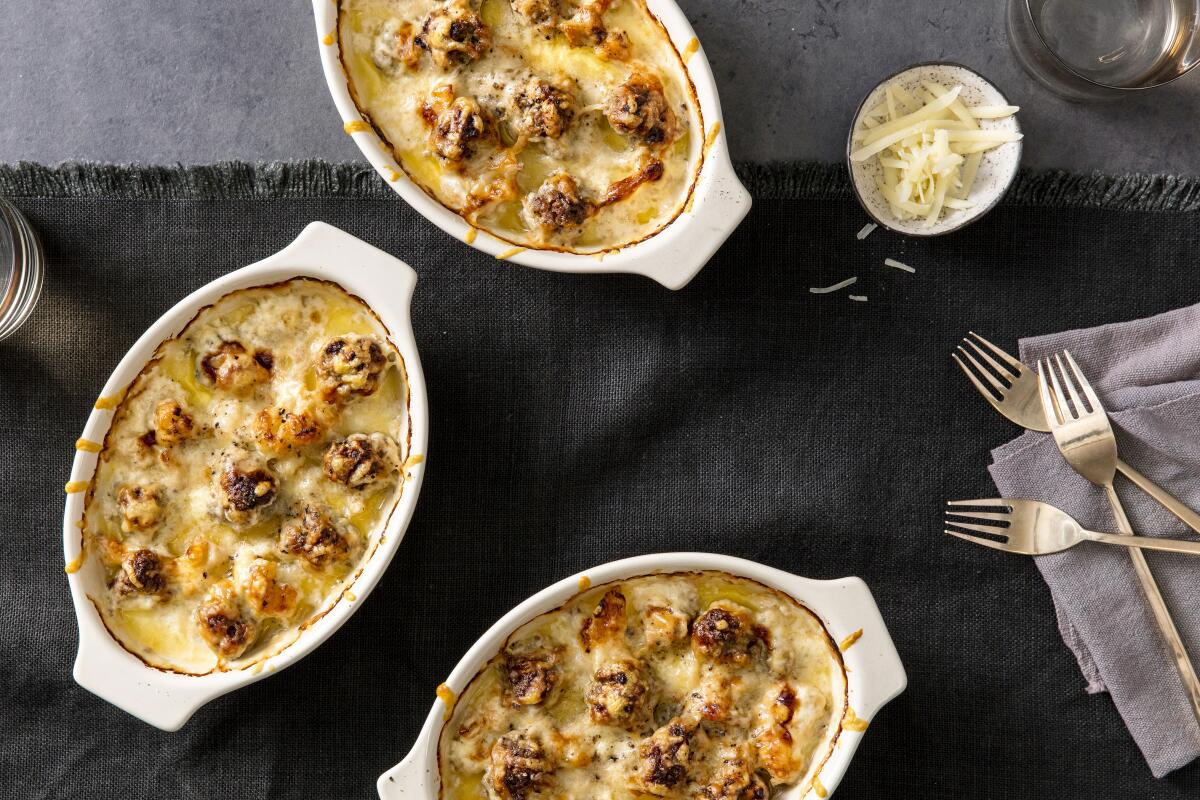
Mustardy Meatball and Cauliflower Gratin With Gruyère
1 hour. Serves 4.
This comforting baked dish could, if you squint your eyes hard enough, pass for baked pasta, swimming in cream and topped with nutty, browned Gruyère cheese. Already have your own favorite homemade or frozen store-bought meatball recipe? Use it here in place of the from-scratch meatballs; just make sure they’re the same size and are thawed completely.
Ingredients
- 1 head cauliflower (about 2 pounds), trimmed and broken into bite-size florets
- Kosher salt
- 1 pound ground beef, preferably 80/20
- 3 tablespoons Dijon mustard
- Freshly ground black pepper
- 1 tablespoon everyday olive oil
- 2 cups heavy cream
- 3 cups grated Gruyère or aged white cheddar
Instructions
- Heat the oven to 450 degrees. Place four 2-cup gratin dishes on a foil-lined baking sheet.
- Bring 1 cup water to a simmer in a large skillet over medium heat. Add the cauliflower, season with salt and cover the skillet. Cook until the cauliflower florets are just tender enough to be pierced with the tip of a knife, about 2 minutes. Uncover and continue cooking until the water evaporates and the cauliflower is fully tender, 4 to 5 minutes more. Divide the cauliflower among the prepared gratin dishes.
- In a medium bowl, break apart the ground beef with your fingers into pieces about the size of a dime. Dollop the mustard over the beef, then season liberally with salt and pepper. Use your fingers to gently toss the beef until it’s well-coated with the seasonings. Roll walnut-size pieces of beef into about 32 balls (1¼-inch-diameter) and divide them among the gratin dishes, resting them on the cauliflower.
- Pour ½ cup cream over the meatballs and cauliflower in each dish, season with salt and pepper, then top each with ¾ cup grated cheese. Bake until the meatballs are cooked through and the cheese is golden brown and bubbling on top, about 30 minutes. Serve while warm.
Variations:
Curry cream: Stir 1 tablespoon curry powder into the cream before dividing it among the gratin dishes.
Lamb and feta: Swap ground lamb for the beef, omit the Gruyère and divide 8 ounces crumbled feta among the dishes after baking.
Broccoli cheddar: Swap broccoli for the cauliflower and sharp cheddar for the Gruyère.
Macros (per serving):
Fat: 94.2 g
Carbs: 5.6 g
Protein: 47.4 g

Brine-Braised Chicken Thighs With Kale and Avocado
1 hour 10 minutes. Serves 4.
Because the chicken here is baked in olive brine, it doesn’t need extra salt, so taste the dish before adding any salt at the end. If you have mixed olives you want to use but no brine, simply season the chicken with salt before adding to the dish and pour over 1/2 cup chicken stock or water in its place.
Ingredients
- 2 pounds bone-in, skin-on chicken thighs (4 large or 6 small)
- Freshly ground black pepper
- 3/4 cup mixed pitted olives with 1/2 cup brine
- 1 small lemon
- 1/4 cup everyday olive oil
- 7 cups (or one 5-ounce bag) lightly packed baby kale or spinach
- 1 avocado, halved and pitted
- Kosher salt (optional)
Instructions
- Heat the oven to 400 degrees.
- Season the chicken thighs all over with pepper, then arrange skin side-up in a 2 1/2-quart shallow baking dish wide enough for there to be a little room between each thigh. Scatter the olives around the chicken, then pour their brine over everything. Using a vegetable peeler, remove the zest from the lemon in strips and scatter them around the chicken. Chop the lemon into 1/2-inch pieces, discarding any seeds, then scatter them around the chicken as well. Drizzle everything with the olive oil.
- Bake the chicken until cooked through and the skin is golden brown on top, about 1 hour.
- Remove the dish from the oven and immediately transfer the chicken pieces to a plate. Stir the kale into the aromatics in the dish, then return the chicken pieces to the dish on top of the wilting greens. Use a spoon to drop chunks of avocado over the chicken and kale and season with salt, if you like.
Variations:
Mozzarella: Swap 6 ounces fresh mozzarella for the avocado, breaking it into bite-size pieces to scatter over the kale.
Orange chicken: Swap 1 orange for the lemon, omit the olives and use 1/2 cup rice vinegar plus 1/4 cup soy sauce instead of the brine. Swap spinach for the kale.
Spicy greens: Add 1/2 to 1 teaspoon crushed red chile flakes along with the olives and swap escarole for the kale. Serve with grated Parmesan.
Macros (per serving):
Fat: 70.9 g
Carbs: 9.4 g
Protein: 40.3 g
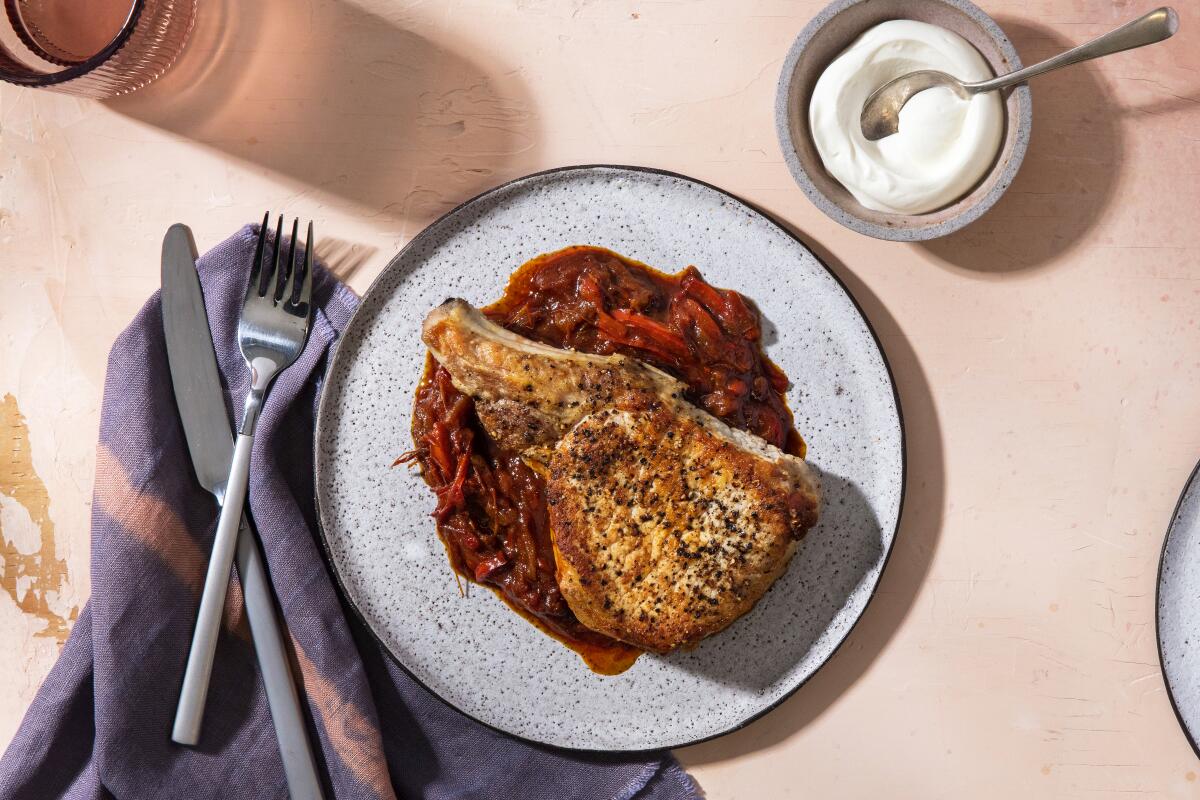
Keto Pork Chop Paprikash
35 minutes. Serves 4.
In traditional paprikash, flour is stirred into sour cream to keep it from splitting when added to the hot pepper sauce, but in the keto diet, that’s not allowed, so the sour cream and sauce are served separately here. Hungarian wax peppers are very common in most grocery stores and, along with hot paprika, lend the sauce its distinctive flavor; though not the exact same, you can substitute Cubanelles, sweet banana peppers or small yellow bell peppers in a pinch.
Ingredients
- 4 tablespoons everyday olive oil
- 4 bone-in pork chops, cut 1 inch thick (about 10 ounces each)
- Kosher salt and freshly ground black pepper
- 1 large red bell pepper, thinly sliced
- 2 Hungarian wax, Cubanelle or sweet banana peppers, thinly sliced
- 2 tablespoons tomato paste
- 2 tablespoons hot Hungarian paprika (or 5 teaspoons sweet paprika and 1 teaspoon cayenne)
- Sour cream, for serving
Instructions
- Heat the oven to 425 degrees. Line a rimmed baking sheet with foil.
- Heat 2 tablespoons olive oil in a large skillet over medium-high heat. Season the pork chops on both sides with salt and pepper, then add 2 chops to the skillet and cook, flipping once halfway through, until golden brown on both sides, about 4 minutes total. Transfer the chops to the prepared baking sheet and repeat with the remaining 2 chops; wipe the skillet clean and reserve.
- Place the chops in the oven and bake until an instant-read thermometer inserted in the thickest part of each reads 160 degrees, 10 to 12 minutes. Remove from the oven and let rest for 10 minutes.
- While the chops bake, return the skillet to medium heat and add the remaining 2 tablespoons olive oil. Add the red pepper, season with salt and cook, stirring, for 6 minutes. Stir in the Hungarian wax peppers and continue cooking until all the peppers are soft and caramelized at the edges, 6 to 8 minutes more. Stir in the tomato paste and paprika, and cook for 1 minute. Add 1 ¼ cups water and stir until evenly combined. Reduce the heat to low and let simmer to blend flavors, about 1 minute more. Remove the paprikash sauce from the heat and season with salt and pepper.
- Divide the pork chops among plates and top each with some paprikash sauce and serve with sour cream on the side.
Variations:
Mushroom: Swap 1 medium yellow onion and 4 ounces cremini mushrooms, thinly sliced, for the sweet peppers and swap 1 tablespoon dried mushroom powder for the paprika.
Creole cream: Swap 1 small yellow onion and 1 small green bell pepper for the sweet peppers, swap 2 tablespoons fresh thyme leaves and ½ teaspoon cayenne for the paprika, and swap 1 ½ cups heavy cream for the water; omit the sour cream.
Mustard leek: Swap 3 large (or 6 small) leeks, thinly sliced, for the sweet peppers and swap 2 tablespoons Dijon mustard for the tomato paste; reduce the paprika to 1 teaspoon.
Macros (per serving):
Fat: 44 g
Carbs: 8.4 g
Protein: 60.5 g
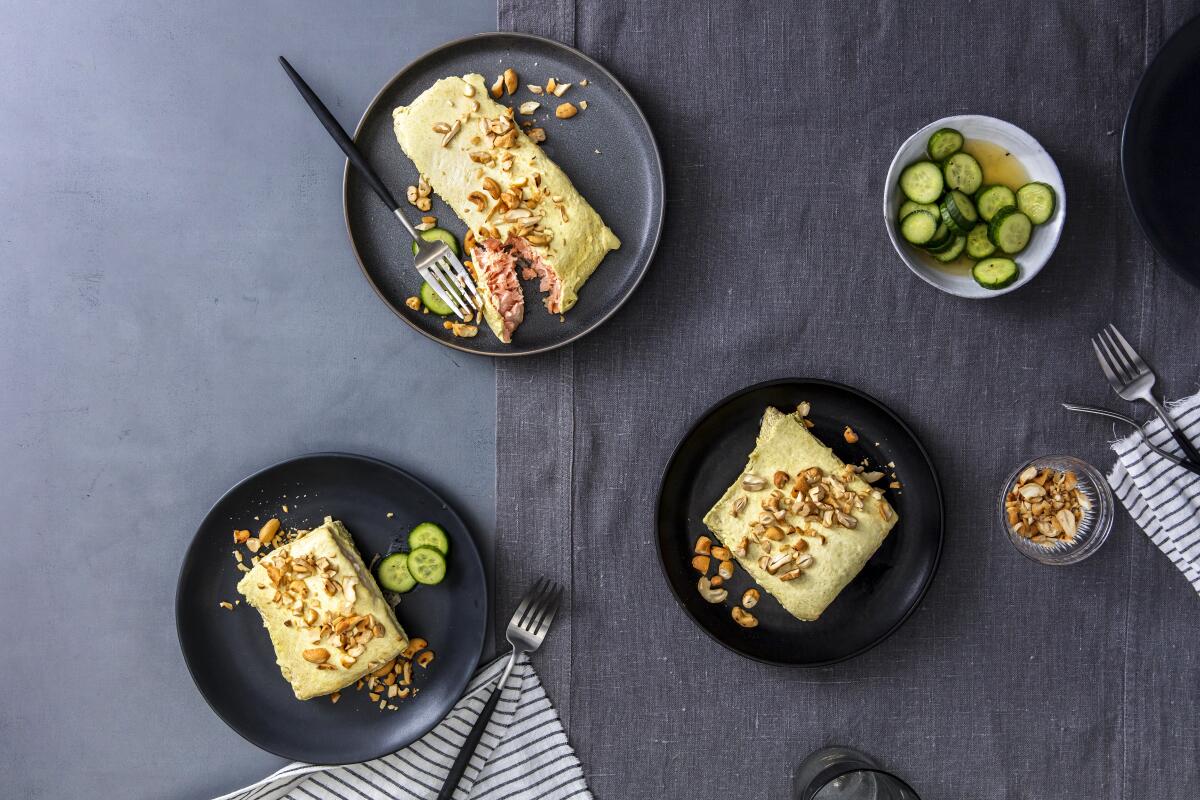
Green Curry and Yogurt-Roasted Salmon
40 minutes. Serves 4.
Baking salmon fillets at a low temperature keeps the flesh tender and moist even when cooked to well-doneness. The yogurt sauce on top helps insulate the salmon too, creating a flavorful creamy coating for the fish that is balanced with salty, crunchy cucumbers and cashews.
Ingredients
- 4 skinless salmon fillets (about 8 ounces each)
- Kosher salt and freshly ground black pepper
- 1 cup full-fat plain Greek yogurt
- 1/3 cup everyday olive oil
- 6 tablespoons (one 4-ounce jar) Thai green curry paste
- 1/2 cup salted cashews
- 6 Persian cucumbers (about 1 pound), thinly sliced
Instructions
- Heat the oven to 325 degrees. Line a rimmed baking sheet with foil.
- Place the salmon fillets on the prepared baking sheet and season all over with salt and pepper. In a small bowl, whisk together the yogurt, olive oil and curry paste until smooth, then spoon evenly over the fillets, spreading to completely cover the tops of the salmon. Bake until an instant-read thermometer inserted in the thickest part of each fillet reads 160 degrees, about 35 minutes for 1- to 1 1/2-inch-thick fillets.
- While the salmon bakes, heat a small skillet over medium-high heat. Add the cashews and cook, tossing occasionally, until toasted and warm, about 2 minutes. Transfer to cutting board and roughly chop.
- Place the cucumber slices in a medium bowl, sprinkle with salt and pepper and let stand, massaging occasionally with your fingers, until soft, at least 30 minutes.
- Remove the salmon from the oven and transfer each fillet to a plate. Scatter the cashews over the top of each fillet and serve with cucumbers on the side.
Variations:
Red peanut: Swap 1/4 cup Thai red curry paste for the green curry paste and swap peanuts for the cashews.
Beet and dill: Swap 1 1/3 cups mayonnaise for the yogurt, omit the green curry paste and season each fillet with 1 tablespoon soy sauce instead of salt and pepper. Omit the cashews and sprinkle the cooked fillets with 1/2 cup roughly chopped dill fronds. Swap 1 pound cooked small red or yellow beets for the cucumbers.
Green Goddess: Swap 1/2 cup finely chopped mixed soft herbs, such as flat-leaf parsley, dill, tarragon and basil, for the green curry paste.
Macros (per serving):
Fat: 32 g
Carbs: 12.8 g
Protein: 51 g
A beginner’s guide to keto
This is a very general list of foods that are both approved and not to eat on a keto diet. If these recipes appeal to you and you want to know more about the diet, consult your physician or a nutritionist to talk about how the diet can fit into your lifestyle.
Foods you can eat:
- Any type of meat, including beef, pork, chicken, lamb, turkey and smoked/cured meats like bacon and sausage.
- All seafood, particularly fatty fish like salmon, trout, tuna and mackerel.
- Eggs; go for organic and pasture-raised, if available.
- All dairy products, especially butter and cream, and full-fat plain Greek yogurt in moderation.
- All types of cheese, including cheddar, goat, cream cheese, blue or mozzarella; choose unprocessed cheeses whenever you can.
- Most nuts, particularly pecans, macadamia nuts and Brazil nuts, plus seeds like flax, pumpkin and chia.
- Natural oils considered healthful on this diet, such as extra virgin olive oil, coconut oil and avocado oil.
- Whole avocados or freshly made guacamole (but no chips).
- Low-carbohydrate vegetables such as dark leafy greens, but also tomatoes, onions, peppers, etc.
- All herbs and spices, including spice mixes and rubs that don’t include sugar.
Foods you cannot eat:
- Anything containing sugar, including soda, fruit juice, smoothies, cakes, ice cream, candy, desserts, etc.
- Any wheat-based products like pasta, cereal, bread, but also rice and other grains.
- All fruit, except for small portions of berries in moderation.
- Any type of beans or legumes, including chickpeas, green peas, kidney beans, lentils, navy beans.
- Any type of starchy root vegetable, including regular and sweet potatoes, carrots, parsnips, turnips, etc.
- Any low-fat or processed diet products, which are often high in carbs or sugar.
- Any sweet condiments or sauces, which contain mostly sugar. Homemade mayonnaise and store-bought mustard are generally OK.
- All alcohol, which is mostly just carbs, so it’s off the menu — except red wine; an occasional glass is fine.
More to Read
Eat your way across L.A.
Get our weekly Tasting Notes newsletter for reviews, news and more.
You may occasionally receive promotional content from the Los Angeles Times.
